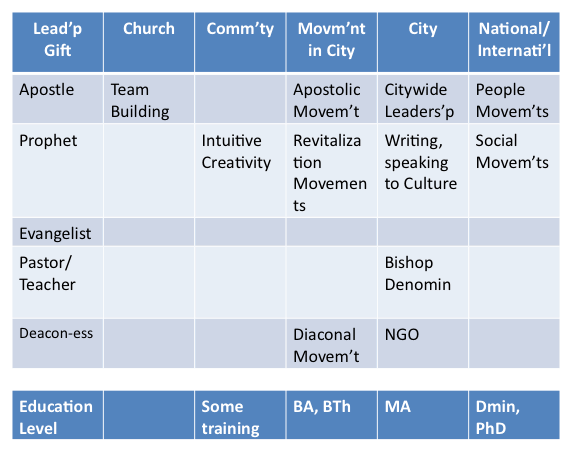How Timing and Context Mould a Leader
Fowler developed an analysis of the Stages of Faith, an untested theory based on other theories of development by Levinson, Erikson, Piaget and Kohlberg.
There are historic precedents across the globe:
Confucius says:
- At 15, I set my heart upon learning.
- At 30, I had planted my feet firm upon the ground.
- At 40, I no longer suffered from perpexities.
- At 50, I knew what were the biddings of heaven.
- At 60, I heard them with a teacher's ear.
- At 70, I could follow the dictates of my own heart; for what I desired no longer overstepped the boundaries of right.
Early ministry develops qualities of Leadership. Successful execution of leadership become a basis for wider scopes of movement leadership. The context of various phases moulds the leader, training him in rpinciles and skills. Critical turning points mark the leaders commitment and vision. We will examine several leaders in order to identify some of these elements.
Part of effectiveness is understanding our humanity, and the seasons of physical and emotonal development and decline.
THE AGES OF A LEADER
From child to schoolboy, to young buck, to maturity, to sage to grandfather, there are seasons to leadership. What is common to each of these?
The Sayings of the Fathers (from the Talmud)
- 5 years is the age for reading (scripture);
- 10 for Misnah (laws);
- 13 for teh Commandments (Bar Mitzvah, moral responsiblity);
- 15 for Gemera (Talmudic discussions, abstract reasoning);
- 18 for Huppa (Wedding canopy);
- 20 for seeking a livelihood (pursueing an occupation)
- 30 for attaining full strength (koah);
- 40 for understanding;
- 50 for giving counsel;
- 60 for becoming an elder (wisdom, old age);
- 70 for white hair;
- 80 for Geruvah (new, special strength of age);
- 90 for being bent under the weight of years;
- 100 for being as if already dead and passed away from the world.
Read the summary of four stages of life in The Seasons of a Man's Life by Levinson.
MEGA-CULTURAL CONTEXT: TRIBAL-URBAN-POSTMODERN CONTEXT
| Band | Tribal | Peasant | Urban | |
|---|---|---|---|---|
| Group Structure | small group | Interlinkied clans | Lord and peasants | Individualized Formalized Structures |
| Leadership | Totemic Leader and consensus | Chief and elders | Lord rules consensus among villagers | Big Man, instituions Individualised decisions |
| Spiritual Structures | clan worship | Tribal gatherings | Rural church | Mega church or house church |
There also has to be a mapping between the level of a leader's operation and the context they are operating in.

The process of building leadership is one fo capital formation at each point. Capital may be formed morally, organizationally, financially. People resources may be garned within organiztions or through networks. In this I am indicating capital as capacity to get and sustain multiplying movment dynamics.
| Personal/ Local | Church / NGO Cluster | Movm’nt in City | City | National/Internati’l | |
| Moral Authority Resources | Symbolic Action | Turning Points | Cultural Analysis | Confrontation with Systemic Evil | Complex Systems Analysis |
| Spiritual Resources | Divine Intervent’ns | Theological Breadth | Visionary Leadership | Engagement with Powers | National Prophetic |
| People Resources | Team | Multiple teams | Network | Coalition | National Network Leaders |
| Structural Resources | Church or NGO | Multiple Churches Multiple Projects | Denom’n | City Network | Nat/Global Networks |
| Coalition Resources | Elders/ Deacons/ Cell Leaders | Cluster Leaders | Coalition / Consortium | Partnerships | Networking |
Other current popular models
-
Clinton's Six Phases of Spiritual Growth
-
Lisa Engdahl's Categories of Movement Leadership
- Four Stages of an Extraordinary Leader
- How do progresions in spiritual development of leaders link to physical/emotional/social development? Oswald Sanders in his classic Spiritual Leadership indicates the difference between the natural and the spiritual ways of leadership. The pressures tend to diversify as we get older. Our roots determine the shoots of new life in later years.
- The Hall-Tonna Values inventory builds from sociological studeis of values, and how those values develop progressively, oringinally based on the concepts from Levinson et al. Used here as a basis to link to the business that Hall has developed that analyzes peoples leadership values and their interfacing with organizational values. This has been an attempt to utilize sociology and psychology to derive a scientific basis for a global theory of personal leadership/values growth.
Readings
- Levinson, D. J. (1978). Tasks and Possibilities of Adult Development. The Seasons of a Man's Life. New York, Balantine Books.
- Clinton, Robert, The Making of a Leader. NavPress
- Collins, Jim (2001). Good to Great. Harper Collins
- Hall, Brian P. (1995). Values Shift: A Guide to Personal and Organizational Transformation. Twin Lights Publishing
- Fowler, James. (1995). Stages of Faith: The Psychology of Human Development and the Quest for Meaning. 978-0060628666.
Students will examine a biblical character and their own "leadership capital" growth by mapping their own timelines, identifying turning points, key theological commitments, spiritual experiences, and contextual learning of critical principles.
